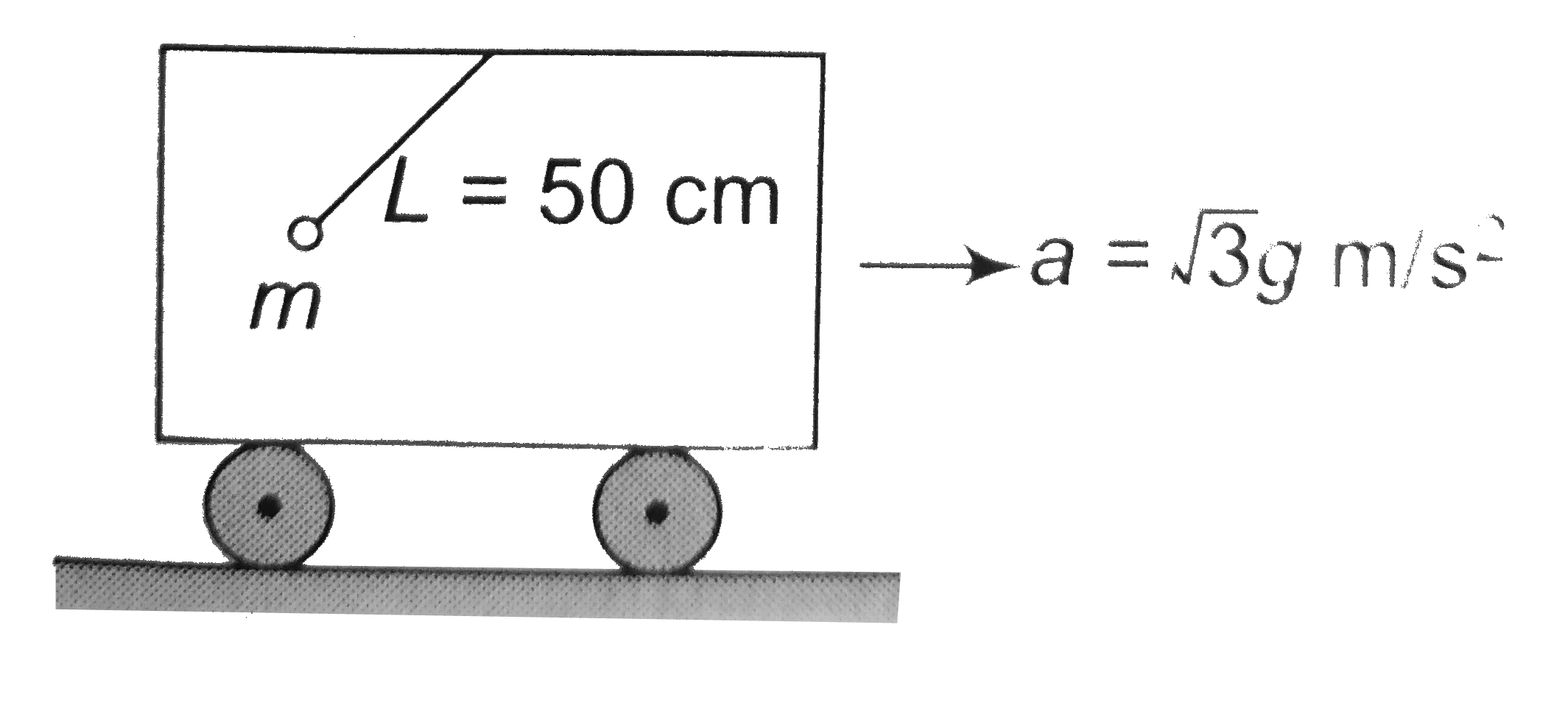A simple pendulum is suspended from the ceiling of a stationary elevator and it oscillates with a small amplitude if the elevator accelerates upwards, the
frequency of oscillation of pendulum increases
frequency of the oscillations of the pendulum decreases
pendulum stops oscillating
time period of oscillations remain same but the amplitude increases
The correct Answer is:C
To solve the problem regarding the behavior of a simple pendulum in an upward accelerating elevator, we can follow these steps:
Step 1: Understand the System
A simple pendulum consists of a mass (bob) attached to a string of length L that swings back and forth. The motion of the pendulum is influenced by gravitational force.
Step 2: Identify the Effective Gravity
When the elevator accelerates upward with acceleration a, the effective gravitational force acting on the pendulum changes. The effective acceleration due to gravity geffective can be expressed as:
geffective=g+a
where g is the acceleration due to gravity (approximately 9.81m/s2).
Step 3: Write the Formula for Time Period
The time period T of a simple pendulum is given by:
T=2π√Lg
When the elevator accelerates upward, we replace g with geffective:
T′=2π√Lg+a
Step 4: Analyze the Effect on Time Period
Since g+a>g, it follows that:
T′=2π√Lg+a<T=2π√Lg
This means that the time period T′ decreases when the elevator accelerates upward.
Step 5: Determine the Effect on Frequency
Frequency f is the reciprocal of the time period:
f=1T
Since the time period T′ decreases, the frequency f′ will increase:
f′=1T′>f=1T
Conclusion
Thus, when the elevator accelerates upwards, the frequency of oscillation of the pendulum increases.
Final Answer
The correct option is A: frequency of oscillation of pendulum increases.
---
A simple pendulum consists of a mass (bob) attached to a string of length L that swings back and forth. The motion of the pendulum is influenced by gravitational force.
When the elevator accelerates upward with acceleration a, the effective gravitational force acting on the pendulum changes. The effective acceleration due to gravity geffective can be expressed as:
geffective=g+a
where g is the acceleration due to gravity (approximately 9.81m/s2).
The time period T of a simple pendulum is given by:
T=2π√Lg
When the elevator accelerates upward, we replace g with geffective:
T′=2π√Lg+a
Since g+a>g, it follows that:
T′=2π√Lg+a<T=2π√Lg
This means that the time period T′ decreases when the elevator accelerates upward.
Frequency f is the reciprocal of the time period:
f=1T
Since the time period T′ decreases, the frequency f′ will increase:
f′=1T′>f=1T
Thus, when the elevator accelerates upwards, the frequency of oscillation of the pendulum increases.
The correct option is A: frequency of oscillation of pendulum increases.
Topper's Solved these Questions
- COMPETITION CARE UNITBOOK - ICSECHAPTER - COMPETITION CARE UNITEXERCISE - OBJECTIVE QUESTIONS FROM PREVIOUS IAS EXAMINATIONS
50 Videos
- COMPETITION CARE UNITBOOK - ICSECHAPTER - COMPETITION CARE UNITEXERCISE - WAVES
98 Videos
- CIRCULAR MOTION BOOK - ICSECHAPTER - CIRCULAR MOTION EXERCISE - MODULE 2 (FROM ROTATIONAL KINETIC ENERGY , WORK ,POWER)
24 Videos
- DIMENSIONSBOOK - ICSECHAPTER - DIMENSIONSEXERCISE - SELECTED PROBLEMS (FROM CONVERSIONS OF ONE SYSTEMS OF UNITS INTO ANOTHER)
9 Videos
Similar Questions
A simple pendulum of length l is suspended through the ceiling of an elevator. Find the time period of small oscillations if the elevator a. is going up with an acceleration a0. b. is going down with an acceleration a0 and c. is moving with a uniform velocity.
View SolutionA simple pendulum is suspended from the ceiling of a car and its period of oscillation is T when the car is at rest. The car starts moving on a horizontal road with a constant acceleration g (equal to the acceleration due to gravity, in magnitude) in the forward direction. To keep the time period same, the length of th pendulum
View Solution
Knowledge Check
A pendulum suspended from the ceiling of train has a period T When the train is at rest. When the train si accelerating with a uniform acceleratio a, the period of oscillation will
AincreaseBdecreaseCremained unaffectedDbecomes infinite
A simple pendulum of length 1 feet suspended from the ceiling of an elevator takes π3 seconds to complete one oscilation. Find the acceleration of the elevator.
View SolutionA pendulum bobof masss 50 g is suspended from the ceiling of an elevator. Find the tension in the string if the elevator a. goes up with acceleration 1.2ms2, b. goes up with deceleration 1.2ms2, c. goes up with uniform velocity, d. goes down with acceleration 1.2ms2 e. goes down with deceleration 1.2ms2 and f. goes downwith uniform velocity.
View SolutionA simple pendulum is suspended from the ceiling a car accelerating uniformly on a horizontal road. If the acceleration is a0 and the length of the pendulum is l, find the time period of small oscillations about the mean position.
View SolutionA particle that hangs from a spring oscillates with an angular frequency of 2rad/s. The spring particle system is suspended from the celling of an elevator car and hangs motionless (relative to the elevator car) as the car descends at a constant speed of 1.5m/s. The car then stops suddenly. (a) With what amplitude does the particle oscillate ? (b) What is the equation of motion for the particle ? (Choose upward as the position direction)
View SolutionA block of mass m is suspended from the ceiling of a stationary standig elevator through a spring of spring constant k. Suddenly, the cable breaks and the elevator starts falling freely. Show that the bklock now executes a simple harmonic motion of amplitude mgk in the elevator
View SolutionA pendulum bob of mass 50 gm is suspended from the ceiling of an elevator. The tension in the string if the elevator goes up with uniform velocity is approximately
View SolutionA simple pendulum 50cm long is suspended from the roof of a acceleration in the horizontal direction with constant acceleration √3gm/s−1. The period of small oscillations of the pendulum about its equilibrium position is (g=π2m/s2) ltbRgt

View Solution
